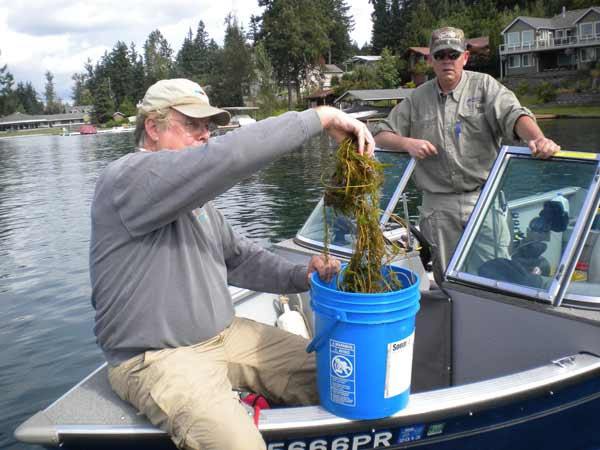After two successful summers of chemical treatment to remove the eurasian milfoil in Lake Tapps, Cascade Water Alliance is taking a more targeted approach this year: pulling out the invasive weed by hand.
“We’re hoping from here on out it will just be maintenance,” said Jon Shimada, capital projects director for Cascade.
Beginning this past week, divers from AquaTechnex are patrolling the lake’s shores and yanking out what milfoil remains. According to Aquatic Biolgist Terry McNabb, two years worth of herbicides have made “huge strides” in battling milfoil, which can be dangerous to swimmers in large quantities, as well as the ecosystem of a body of water.
“People tend to forget that two years ago there was a bay this size you couldn’t see the water,” McNabb said Wednesday from the company’s boat, located in a cove near then north end of the lake.
This year, the weed is still present in the lake, but at a greatly reduced number. Coves and bays treated with the herbicide over the past two summers are still mostly clear and even the untreated areas have nowhere near the level of infestation as parts of the lake did just last summer.
 Eurasian milfoil is a non-native species that can reproduce itself from a small cutting, which means that every piece of milfoil is potentially another plant if any is left in the water or even stuck to the bottom of a boat loaded into the lake.
Eurasian milfoil is a non-native species that can reproduce itself from a small cutting, which means that every piece of milfoil is potentially another plant if any is left in the water or even stuck to the bottom of a boat loaded into the lake.
“The more times it’s cut, the more plants you can have,” said Lake Manager Joe Mickelson, adding, “It’ll last on a trailer in 90 degrees for four weeks.”
This year, because of the success of the previous two chemical treatments, which cost more than $550,000 combined, the company is saving money by pulling out the remaining plants by hand.
The cost this year is closer to $30,000.
To identify locations that need attention, Cascade is also asking residents to look at their own shores and let the company know of any milfoil beds. There is also some confusion among non-biologists as to which are native plants, and which are the invasive strain of milfoil, which often blends itself in with native plant beds.
When in the water, milfoil as a fluffier look than most of the local species of plant. The leaves of the plant form like the needles of an evergreen tree, with eurasian milfoil having many pairs of closely-packed segments.
Residents can email a picture of a plant they find in the water to Cascade for confirmation of milfoil.
In the photo, Eurasian milfoil is on the left, compared to a native species of plant.
Shimoda and McNabb both said crews would be making a map of milfoil hot spots for crews to visit and eradicate because the key is making sure to catch it before it gets out of hand.
“The key thing is to have some kind of presence,” McNabb said.
Residents who think they may have a milfoil infestation can send a photo to contact@cascadewater,org.


